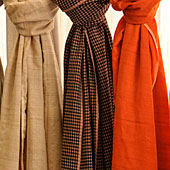Tibetan Cotton Weaving
Generally thick cotton yarn is preferred for making (weaving) of these clothing. Yarn in the hank form are wound on to pirns or bobbins which is either taken for the warp or weft part of the loom. Bobbin of about 104 numbers are fixed on the creels to prepare the warp beam of the loom. Each yarn is passed through the heddle shaft wire as per the pattern of the design to be obtained.
Color yarns are inserted (if required) in the pattern of design to the required portions in the beam and the loaded beam is fixed to the loom with a four foot pedal which has separate passage. Each pedal is connected to the four heddle shaft where the design is inserted as per the pattern of design. With the help of heddles, foot pedals fly shuttle is passed through the warp shed for continuous weaving. Locks and weights are fixed for balancing the movement of the loom at the back of the loom to balance the load and the yarn is inserted through the warp shed it is beaten with the beater through a handle.
There are two options in dyeing, either the yarns are dyed in the yarn stage or it is dyed after the fabric is made only on requirement. If colored pattern of fabrics are required, it is sampled with cotton cloth of about 5 grams and then heated with common salt and dye powders of the required color for about an hour to which soda ash is added for color uptake. If the dye color is as per the requirement it is proceeded if not trial and error method is followed till the required color is obtained. Then dyeing is proceeded to the roll of fabric of the required length and width.
As the people living in the hilly region of Himachal Pradesh, prefer very light colored clothing of grey, white and red color. Cotton shawls are mostly preferred at summer times and woolen shawls in colder seasons.



































